
Complete Guide To Replatforming – Definition and Best Practices
In today’s digital world, staying competitive means evolving continuously. But what happens when your software can no longer keep up?
The solution is replatforming—a vital step in digital transformation that modernizes applications, boosts performance, and leverages cloud computing.
This guide delves into replatforming, its benefits, and best practices for success.
Key Takeaways
- Replatforming is an application migration strategy which allows businesses to benefit from cloud capabilities and infrastructure while retaining the core functionality of their existing applications.
- Replatforming offers organizations improved cost efficiency, scalability and performance, enhanced security & compliance, improved availability, and the ability to facilitate innovation.
- Examples from Amazon, Netflix & Capital One showcase replatforming’s effectiveness as a digital transformation tool. Proper planning & management are essential for successful outcomes.
Understanding replatforming
The world of cloud migration can seem daunting, and working with legacy applications is a challenge in and of itself. Various cloud migration approaches are available, and replatforming is one of the most popular.
What is it and why is it important? Let’s find out!
Definition of replatforming
Software replatforming refers to the process of migrating software applications, data, and operations from one computing platform or architecture to another. It is undertaken to enhance functionality, improve performance, or enable scalability, typically involving shifts in the underlying technology stack, data schemas, or operating environments.
This might encompass changes in databases, programming languages, application infrastructure, and more, with a goal of meeting evolving business requirements and leveraging newer, often more efficient, technologies. Replatforming enables businesses to take advantage of the benefits associated with cloud deployment models.
Unlike cloud-native architecture, which is designed for the cloud right from the beginning, replatforming involves adapting an application to better suit the cloud environment without altering its fundamental architecture.
This approach allows businesses to reap the benefits of cloud computing, including cloud capabilities and cloud infrastructure, while minimizing disruptions and maintaining the core functionality of their applications.
Why to replatform existing applications?
Why do application replatforming at all?
Well, to take advantage of cloud computing and modern enterprise software architectures, of course!
Modernizing legacy applications can significantly improve performance and take advantage of cloud-native capabilities. With a well-executed replatforming project, organizations can:
- Improve application performance,
- Increase elasticity,
- Automate processes,
- Ultimately lead to cost optimization.
We will discuss the benefits of replatforming in more detail later. For now, it’s important to note that the motivations for modernizing applications can be broken down into IT benefits and business benefits. The latter include:
- Updating specific and problematic components of an application,
- Transitioning away from legacy software infrastructure,
- Streamlinig operations,
- Intrioducting more cutting-edge, and competitive features.
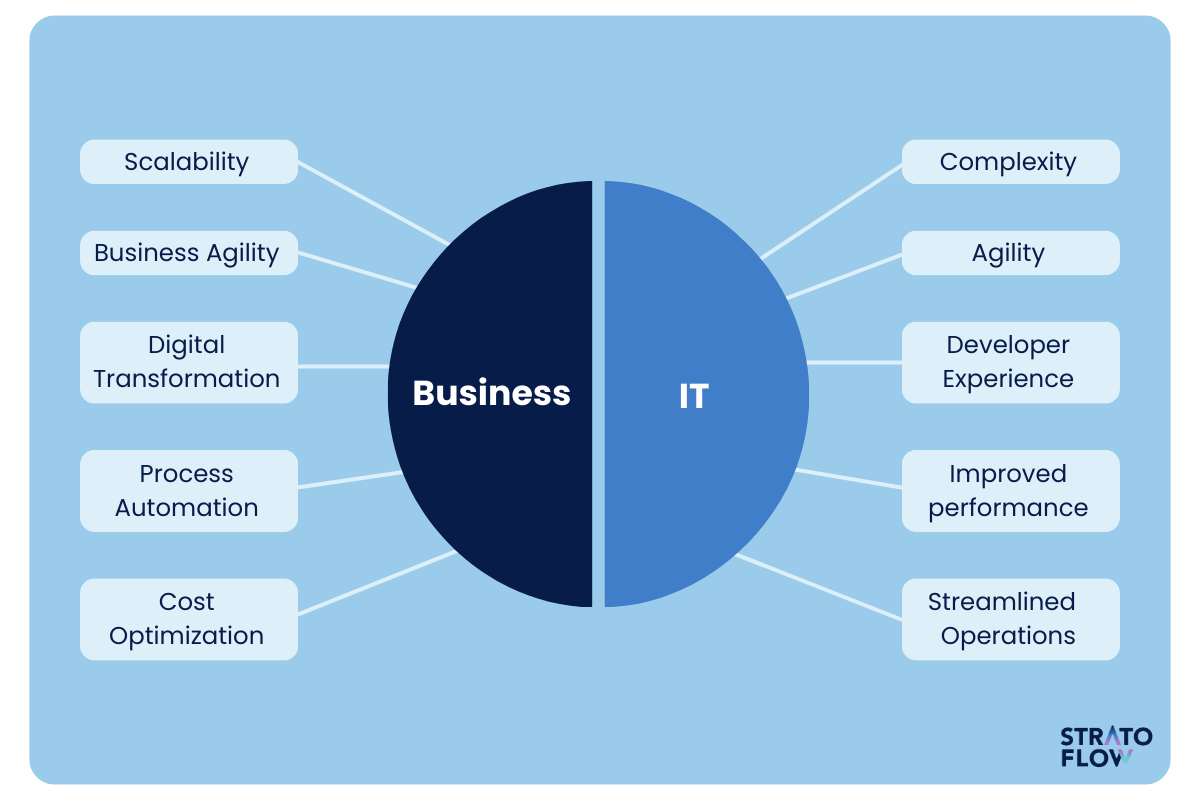
How does replatforming work?
The replatforming process can vary depending on the industry, application, and business requirements. Having said that, every successful replatforming project must adhere to a common framework and undergo careful planning phase. This will help guide the process and ensure that it is managed effectively. The framework includes
- Assessing business needs
- Conducting cost analysis
- Creating a cloud migration strategy
- Updating and testing the application
- Managing risks and challenges associated with the migration
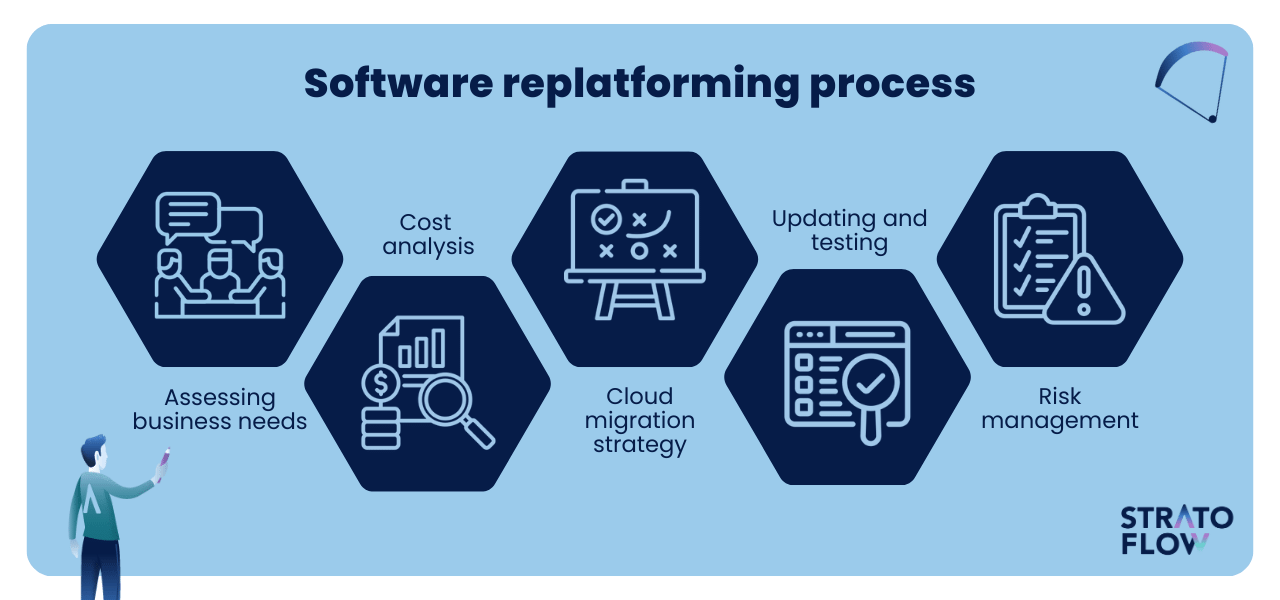
The migration process should be done in phases, as creating the layer that intercepts requests between front-end and back-end systems is an important aspect of the replatforming process.
This in turn allows for a smoother transition and minimizes the potential for disruption, ultimately leading to a successful replatforming project.
[Read also: Minimum Viable Product (MVP): What Is It And How To Build One?]
Replatforming Vs. Rehosting Vs. Refactoring: What’s the difference?
While researching this topic, you may have come across terms like refactoring, rehosting, and rearchitecting. They all seem very similar and are closely related to replatforming.
So what’s the difference?
Although these strategies fall under the umbrella of cloud migration, there are important differences between replatforming, rehosting, and refactoring.
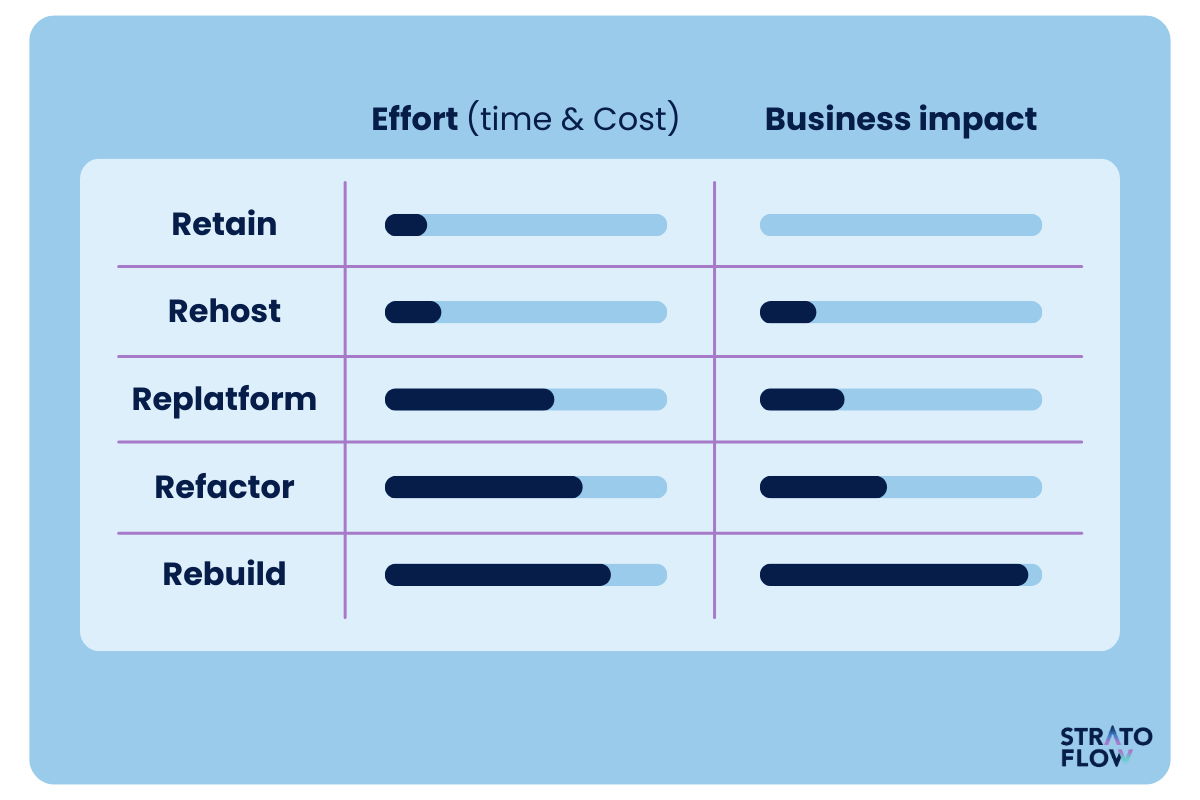
Replatforming involves modifying an application to better suit the cloud environment and improve performance, while rehosting, also known as “lift and shift,” simply moves the application without modification. Refactoring, on the other hand, involves significant changes to the application’s code base for fine-tuning and flexibility, which can be more time-consuming and costly than replatforming.
There’s also a third, nuclear option – the complete rebuilding of an entire application from the ground up. While this is the most resource-intensive and complex, it provides the greatest strategic benefits in terms of business impact.
Replatforming is often favored by organizations because it strikes a nice balance between these three options – offering greatly expanded capabilities and a less complicated migration process.
Let’s take a closer look at these three key strategies.
Replatform vs. Rehosting (Lift and Shift)
Two different approaches to cloud migration are replatforming and rehosting.
While replatforming makes changes to an application to better fit the cloud and optimize performance, rehosting simply moves the application to a new cloud environment without any changes.
Rehosting is more suitable for:
- relatively uncomplicated applications
- applications with limited integrations and dependencies
- applications where a speedy migration with minimal downtime is desired
However, a major drawback of rehosting is that it does not take full advantage of cloud-native features, which may limit the potential benefits of cloud computing.
Replatform vs. Refactoring (Re-architecting)
Replatforming and refactoring differ primarily in the extent of changes made to the application during the migration process.
Replatforming updates specific components of an application to improve cloud performance, while refactoring requires extensive revisions to the application code base for optimization and adaptability.
Refactoring is appropriate for long-term projects where the ultimate return on investment justifies the initial effort and there is time to wait for those benefits to be realized. However, refactoring can be more costly and time-consuming than replatforming, making the latter a more attractive option for many organizations looking to modernize their applications while minimizing disruption.
Five key benefits of replatforming for modern businesses
Embracing the replatforming process can provide numerous benefits for organizations looking to modernize their applications and capitalize on the advantages of cloud computing. Some of these benefits include:
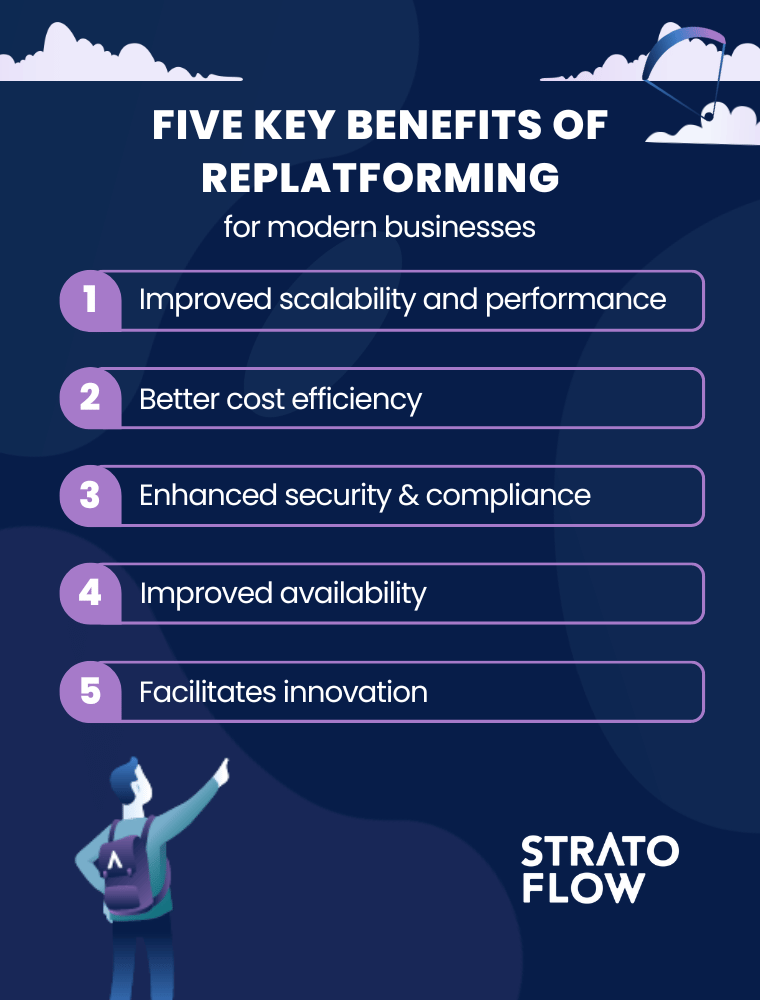
Improved scalability and performance
Improved application scalability and performance is by far the most important benefit of replatforming. By migrating to a cloud-based environment, applications can scale more efficiently and handle increased workloads, ultimately resulting in better overall performance.
This improved cloud scalability enables organizations to
- Grow and adapt to fluctuating market demands
- Ensure that their applications can handle increased traffic and demands
- Maintain performance and user experience
Better cost efficiency
Cost efficiency, on the other hand, is the key benefit from a business perspective.
By leveraging cloud-native capabilities, replatforming can improve cost efficiency by reducing operational costs and increasing return on investment (ROI). By optimizing resource utilization and taking full advantage of cloud-based services, organizations can realize significant cost savings and improve their bottom line. Acquiring cloud and automation skills is essential for organizations to effectively leverage cloud-native capabilities and realize these benefits. This makes replatforming an attractive option for organizations looking to modernize their applications while keeping costs in check.
Enhanced security & compliance
Replatforming can significantly improve the security and compliance aspects of an application, which are critical factors for any organization. By leveraging the security features provided by cloud providers, such as encryption, data backup, and access controls, organizations can ensure that their applications remain secure and compliant with industry standards.
This not only protects sensitive data and intellectual property, but also helps maintain customer trust and brand reputation.
Improved availability
Improved availability is another key benefit of replatforming. By migrating applications to a cloud-based environment, organizations can take advantage of cloud-based redundancy and failover capabilities, ensuring that their applications remain accessible and operational even in the face of unexpected outages or disruptions.
This increased availability can result in improved customer satisfaction, increased operational efficiency, and ultimately cost savings for the business, including reduced maintenance costs.
Facilitates innovation
Finally, replatforming enables organizations to adopt new technologies and innovate faster.
Why is this important?
Well, to stay competitive, of course.
By modernizing their applications and embracing cloud-native capabilities, enterprises can:
- Better meet the needs of their customers
- Increase market share
- Build customer loyalty
- Achieve long-term success
Replatforming serves as a catalyst for innovation, empowering organizations to explore new possibilities and drive growth in today’s rapidly evolving digital landscape.
Key considerations for successful replatforming
There are several key considerations must be taken into account by organizations to ensure the success of a replatforming project. By carefully addressing these factors, organizations can maximize the benefits of replatforming while minimizing disruptions and potential pitfalls. These key considerations include:
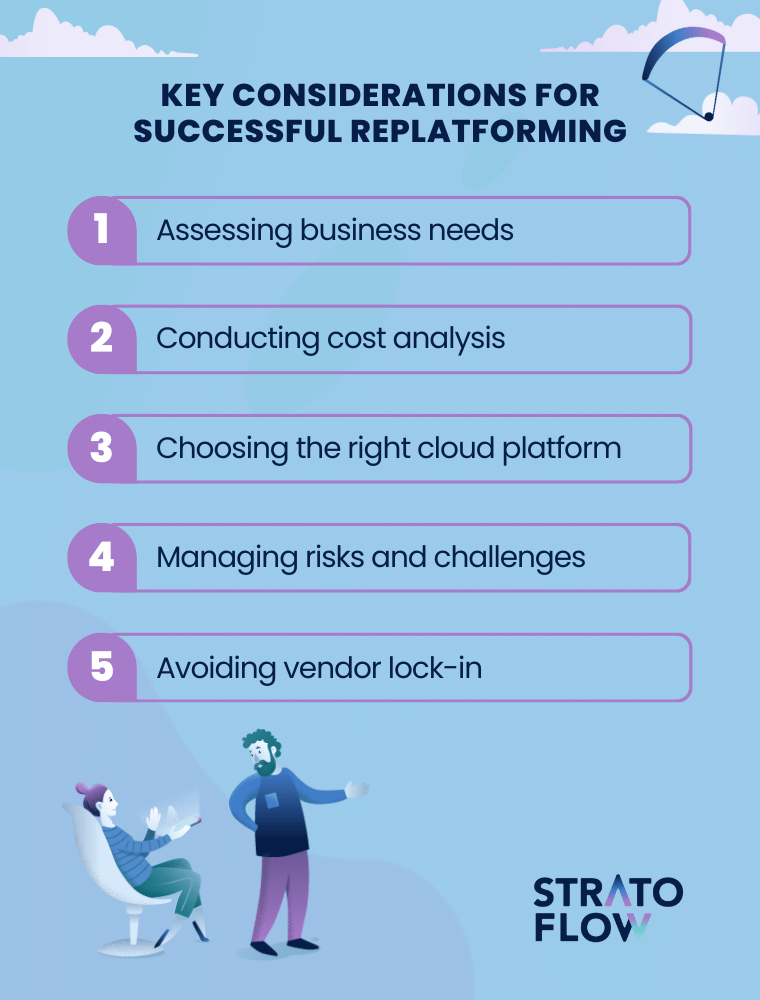
Assessing business needs
What’s the first step in building a startup?
Making sure there’s a need for what we’re trying to do.
When it comes to replatforming a software product, the first step is the same.
Identifying specific needs and business goals is critical before embarking on a replatforming project. This includes evaluating the current technology stack, understanding the organization’s growth plans, and assessing the application’s requirements. By gaining a clear understanding of business needs, organizations can better plan the migration process, ensure a smooth transition, and ultimately achieve a successful replatforming project.
Conducting cost analysis
Determining the financial viability and potential return on investment of a replatforming project necessitates a thorough cost analysis. This involves considering factors such as:
- The cost of the new platform,
- Migration expenses,
- Development and customization costs,
- Training and support costs,
- Potential downtime or loss of revenue during the transition.
By analyzing these factors, organizations can make informed decisions about whether replatforming is the right choice for their needs and ensure a positive ROI.
Choosing the right cloud platform
The success of a replatforming project hinges on selecting the right cloud platform.
This involves evaluating the features, pricing, scalability, and support provided by each platform, and choosing the one that best fits the organization’s needs and requirements.
Some popular options for cloud services, each offering a unique set of cloud features, include cloud platforms such as:
Taking the time to thoroughly research and compare these cloud platforms will help ensure a smooth migration and minimize potential issues down the road.
Managing risks and challenges
A successful project necessitates the identification and mitigation of potential risks and challenges associated with replatforming. Some common challenges include:
- Technical debt
- Working with legacy systems
- Data migration
- Downtime
- Integration issues
By proactively addressing these challenges and implementing best practices, organizations can minimize disruptions and ensure a smooth transition to the new platform. Regular monitoring and testing throughout the migration process can also help identify and resolve issues before they escalate, further reducing risks and ensuring a successful replatforming project.
Avoiding vendor lock-in
For organizations undergoing a replatforming project, it’s critical to ensure flexibility and avoid vendor lock-in.
Vendor lock-in occurs when an organization becomes dependent on a single cloud provider’s technology, making it difficult or costly to switch to another provider.
To avoid vendor lock-in, organizations should consider using open-source platforms, such as Openkoda, or leveraging multiple cloud providers. By doing so, organizations can maintain flexibility and adapt to changing market demands and technological advancements, ensuring the long-term success of their replatforming efforts.
Challenges with replatforming
While the benefits are numerous, replatforming comes with its own set of challenges.
By understanding and addressing these challenges, organizations can better navigate the complexities of replatforming and ensure a smoother transition to a modern, cloud-based infrastructure. This, in turn, will help businesses reap the full benefits of cloud computing and stay ahead of the competition in today’s rapidly changing digital landscape. Five of the key challenges associated with software replatforming include:
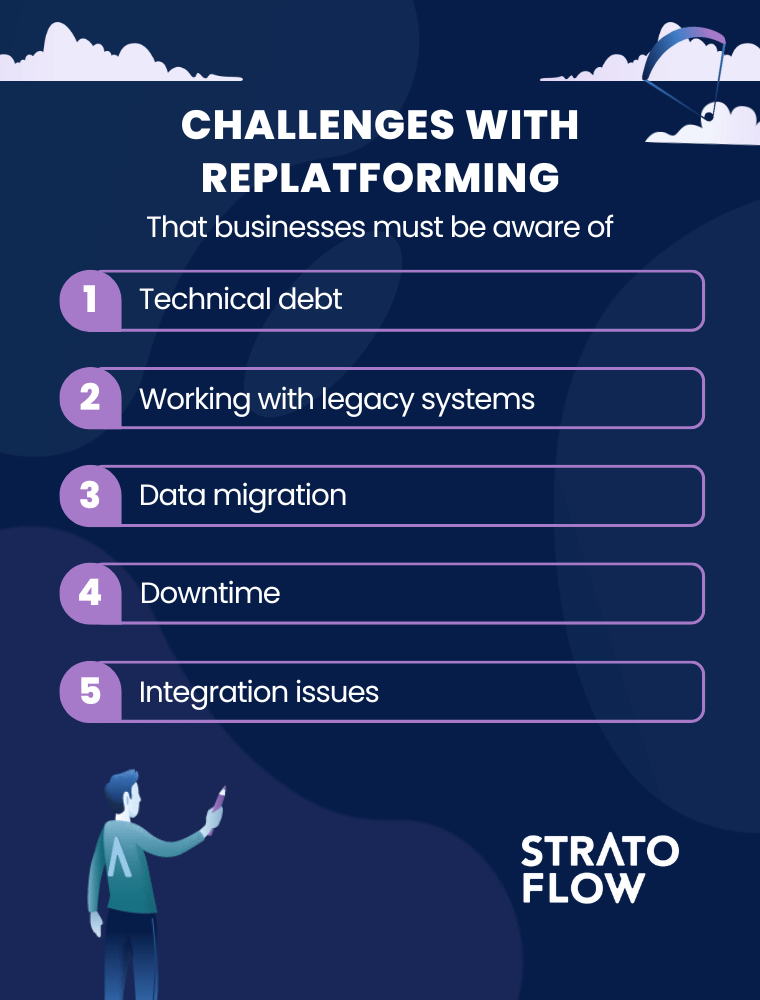
Technical debt
Any replatforming project must consider the critical aspect of managing technical debt and avoiding scope creep.
As some people say: technical debt is the cost of choosing a more expedient solution rather than a more comprehensive and time-consuming one.
Replatforming can create new technical debt if not managed properly, leading to increased cost and complexity in the long run. To effectively manage technical debt, organizations should carefully plan their replatforming projects to ensure that all necessary changes are made while minimizing the introduction of new debt.
Working with legacy systems
Integrating and modernizing legacy software systems is often a complex and time-consuming aspect of replatforming. Legacy systems can be characterized by outdated technology, lack of proper software documentation, security vulnerabilities, and incompatibility with modern systems.
During the replatforming process, organizations must carefully assess their existing infrastructure and determine the best approach to modernize these systems while minimizing disruptions to business operations. This may involve replacing or updating specific components of the legacy system, or even completely rearchitecting the application to better suit the cloud environment.
Data migration
Data migration during replatforming can pose a challenging task with the risk of data loss or corruption. To ensure a successful replatforming project, it is crucial to:
- Properly manage the data migration process.
- Accurately transfer data between systems.
- Ensure the application remains functional throughout the migration process.
By following these steps, you can minimize the risk of data issues and ensure a smooth transition to the new platform.
Organizations should plan the migration in advance, test the process, and utilize automated tools to minimize the risk of data loss or corruption and ensure a smooth transition to the new platform.
Downtime
To avoid negative impacts on business operations and customer satisfaction, minimizing downtime during replatforming is critical. Downtime can result from various factors, such as technical issues, data migration, or integration challenges.
To minimize downtime, organizations should plan their replatforming projects in phases, ensuring that any potential disruptions are carefully managed and mitigated. By proactively addressing potential downtime issues, businesses can maintain the trust of their customers and ensure a successful replatforming project.
Integration issues
Ensuring seamless integration between the replatformed application and other systems is critical to the success of a replatforming project. Integration issues can arise if the new platform is not compatible with existing systems, resulting in disruptions in data flow and application functionality.
To avoid integration problems, organizations should carefully plan their replatforming projects to ensure that all necessary modifications are made to enable seamless communication between the new platform and existing systems. By proactively addressing integration challenges, organizations can ensure a smooth transition to the new platform and minimize potential disruptions to business operations.
Replatforming examples
The benefits and potential of this cloud migration approach can be seen in successful replatforming projects.
Companies such as Amazon, Netflix, and Capital One have undertaken replatforming projects to achieve greater scalability, agility, and cost-effectiveness while improving performance and security.
Stratoflow software developers also have experience in software replatforming.
A major hotel booking aggregator in the UK was struggling with system scalability due to an aging database architecture. To address this need, our top-notch experts created a complete system redesign from database-oriented processing to a modern IMDG platform meaning that the new solution keeps a complete set of data required for the system’s core functionality in memory.
The result?
The system is now able to handle 50% more traffic (over 300 million queries per day) with response times reduced by up to 60%.
And what about the scalability?
New system achieved almost linear scalability, and it’s overall efficiency was improved by almost 70%.
These examples demonstrate the true power of replatforming as a driver of digital transformation and underscore its role as a tool for regaining competitive advantage.
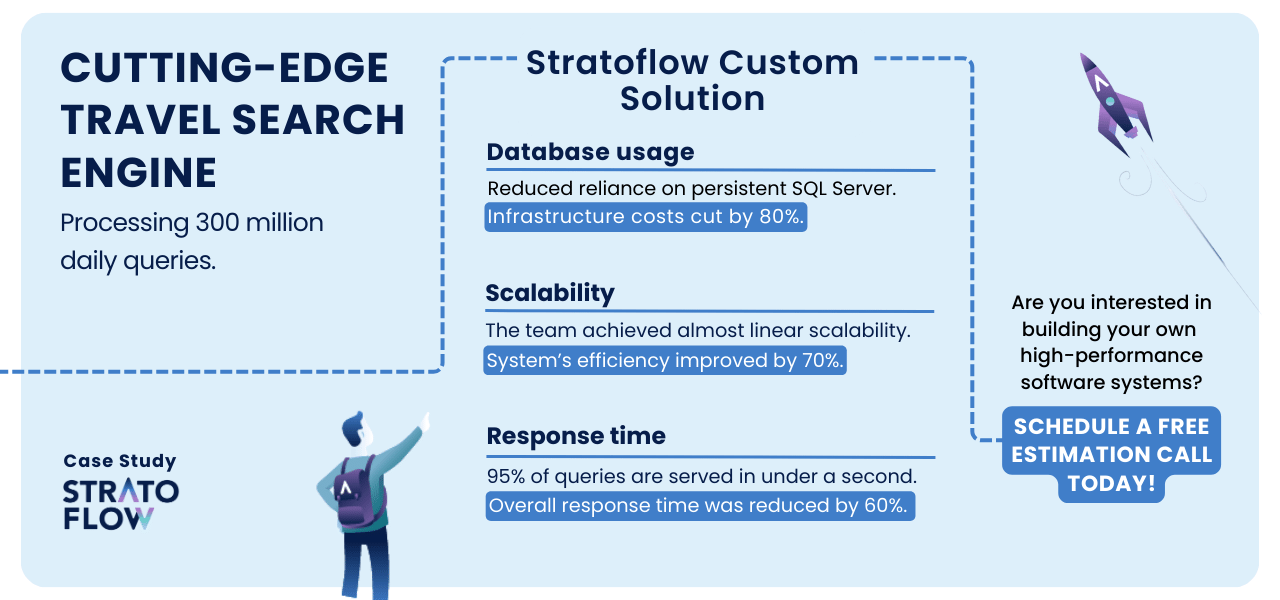
Conclusion
As a critical part of digital transformation, replatforming helps organizations modernize their applications, improve performance, and take advantage of cloud computing.
By embracing this approach, organizations can remain competitive in today’s rapidly evolving digital landscape and unlock new opportunities for growth and innovation.
FAQ
What is an example of Replatforming?
Replatforming is a process of transferring applications and services from legacy data center infrastructure to the cloud, as evidenced by successful examples like Netflix migrating from its legacy system to Amazon Web Services (AWS) and Capital One transitioning from its mainframe to the cloud.
What are the key benefits of replatforming?
Replatforming offers a range of key benefits including cost efficiency, scalability, enhanced security, improved availability, and innovation.
What are some challenges faced during replatforming?
Replatforming can be challenging due to technical debt, outdated legacy systems, data migration and integration issues, leading to potential downtime.
Related Posts
Thank you for taking the time to read our blog post!